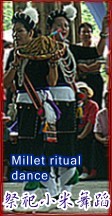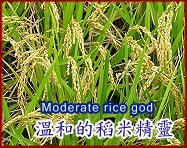| |
|
|
|
|
|
 |
 |
|
|
|
In the past, millet is the main crops for Amis. Many celebrations are about the
growing process of millet (planting, weeding, and reaping), the harvest festival
activities of illsin are also evolved through these ceremonies. Millet has
gradually lost its important position after the introduction of rice. |
|
|
|
【★
The harvest festival at millet time ★ 】 |
|
 Millet
is called Hafay or Lamlo in Amis
language. With high nutritive value, millet is
called the "king of grains," but it is usually
forgotten by people. In recent years it has
valued by people with the health preserving
tendency, some orient countries have listed it
as one of the healthy food. Millet
is called Hafay or Lamlo in Amis
language. With high nutritive value, millet is
called the "king of grains," but it is usually
forgotten by people. In recent years it has
valued by people with the health preserving
tendency, some orient countries have listed it
as one of the healthy food.
Before rice was
introduced to Taiwan in the 19th
century, millet is the main crop for Amis, and
it is also the primary crop for them. After the
harvest of millet, each tribe will hold big
celebrations to express their thanks to gods. |
|
|
|
《
Millet God has many taboos
》
|
|
 Amis
believes that millet is the most sensitive one
in plant gods, and it is also the most
inconvenient crop. Millet god has special
spiritualism; it has sacred eyes, ears, senses.
Therefore it has many taboos, if people have
violated them; they may have to suffer
calamities. Therefore, when the farmers reap
millet in the field, they have to be careful
about their words and even their movements,
otherwise they may offend the millet god and
bring disasters to themselves, or even natural
and man-made disaster and finally make them
cannot harvest the millet. Amis
believes that millet is the most sensitive one
in plant gods, and it is also the most
inconvenient crop. Millet god has special
spiritualism; it has sacred eyes, ears, senses.
Therefore it has many taboos, if people have
violated them; they may have to suffer
calamities. Therefore, when the farmers reap
millet in the field, they have to be careful
about their words and even their movements,
otherwise they may offend the millet god and
bring disasters to themselves, or even natural
and man-made disaster and finally make them
cannot harvest the millet. |
|
《Millet
ceremony varieties》
|
|
In millet time, the ups and downs of millet
production rest with the holding of different
ceremonies rather than the artificial
cultivation techniques. Therefore different
ceremonies have to be hold since planting to
harvest, the following table has listed the
rituals that have to be hold mating the growing
process of millet. |
|
|
|
1) Hunting ritual (Miaop):
Ten or fifteen days before plant,
the male will go out to hunt together to
celebrate the harvest of millet in advance.
2) Preparation ritual (Matongdaw): Before
planting, the family should eat up all the fish
at home and wash the instrument that fish are
placed to avoid that it may go against millet
god.
3) Sowing ritual (Pafraanf): When plant
millet, the farmers should pray to millet god,
Ciohafayaw for the good weather and millet
harvest.
4) Weeding ritual (Mikuias): It happens
at weeding and restriction of stock time,
symbolizes that the millet will grow up.
5) Expelling worms ritual (Mitapoh): It
is not necessary, but will be held when millet
suffers insect pest.
6) Pray for sunshine ritual (Pakacidal):
It is not necessary, but will be held when the
rain has lasted for many days pray for the sunny
weather.
7) Harvest ritual (Milikoc): Before
harvest, all the villagers will obey rules, they
cannot eat shish and should wash clean the
instrument that fish are placed.
8) Harvest beginning ritual (Mihafay):
The morning which the officially harvest of
millet begins, pray for the smooth harvest.
9) Warehouse ritual (Minaang): Store the
millet in the warehouse for the first time, pray
for safe.
10) Thanksgiving ritual (Misalisin): When
all the millets are placed in the warehouse, the
tribe will hold comprehensive ritual; this is
also the most important one as well as the
origin of modern harvest festival. |
|
|
|
《
Types of ceremony》 |
|
The chief and each male age class and priests
will preside over the rituals together, it takes
the original religious form, the content is
simple and solemn, there are no special songs
and dances, its main content is to offer
sacrifice to ancestors, and it is not as
complex, bold and jolly as current harvest
festival. In the original ceremony of millet
time, the harvested millet and other crops,
pork, Pinang, sticky rice and wine and sometimes
even the hunted human head are offered as the
sacrifices.
|
|
|
|
|
|
【★
The
harvest festival at rice time
★】 |
|
Rice is called Panany or Tipos in
Amis language.
Its cultivation method is different from millet,
not so complex. For the intervention of Han,
Amis has gradually abandoned millet cultivation
in the beginning of the 20th century,
and rice has become the main crop. Therefore,
they have entered another agriculture society,
the sacrifice course is also amended. |
|
|
|
《
Spiritualism
》
|
|
 Millet
and rice are the crops of totally different
spiritualism. Millet god is fury and cannot be
offended, while rice god is gentle and kind, it
usually will not hurt human.
Therefore, at harvest
time, men can sing highly when they plant, and
women can join in the singing. Millet
and rice are the crops of totally different
spiritualism. Millet god is fury and cannot be
offended, while rice god is gentle and kind, it
usually will not hurt human.
Therefore, at harvest
time, men can sing highly when they plant, and
women can join in the singing. |
|
|
|
《
Ceremony varieties
》 |
|
In rice time, the different kinds of ceremonies
of millet time are not completely abolished. A
small part of ceremonies have been changed to
the rice ceremony, but the taboos are not as
complex as that in millet time. The following
table is the sacrifice ceremonies that must be
held matching the growth of rice: |
|
|
|
1)Water
conducting ritual (Palinanom): Pray to the
god in charge of water that there will be no
lack of water.
2)Seedling ritual (Misacapox): Pray for
the gods to give the good weather so that the
crops may grow up easily.
3)Reaping ritual (Mitipos): Pray to the
gods for successful harvest.
4)Pray for rain ritual (Pakaorar): It is
not nessary, if there is no rain it will be held
to pray for the rain.
5)Pray for sunshine ritual (Pakacidal):
It is not necessary, but will be held when the
rain has lasted for many days pray for the sunny
weather.
6)Warehouse ritual (Minaang): Store the
millet in the warehouse for the first time, pray
for safe.
7)Thanksgiving ritual (Misalisin): When
all the millets are placed in the warehouse, the
tribe will hold comprehensive ritual; this is
also the most important one as well as the
origin of modern harvest festival.
|
|
|
|
《
Ceremony type
》 |
|
Similar to millet ceremony, but the villagers does not use human head any more,
they use the sacrifices which are mainly composed of pork, and the ceremony is
simple and solemn, but there are not so many taboos as that in millet time. The
reason that Amis has changed millet to rice is that:
1) Millet ceremony is complex.
2) There are many millet taboos.
3) Millet production is not as good as rice. |
|
|

 |
|
|
|
|